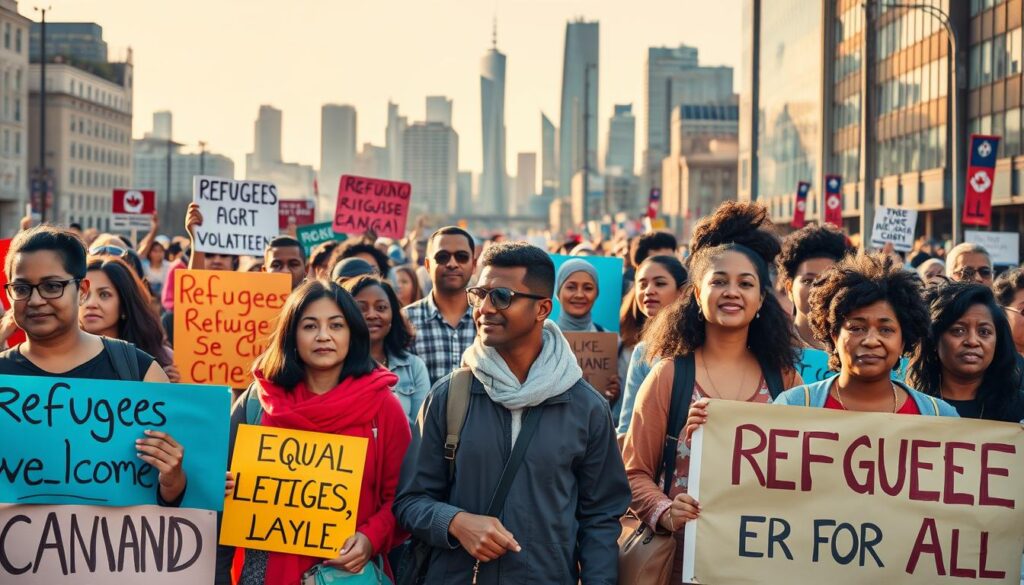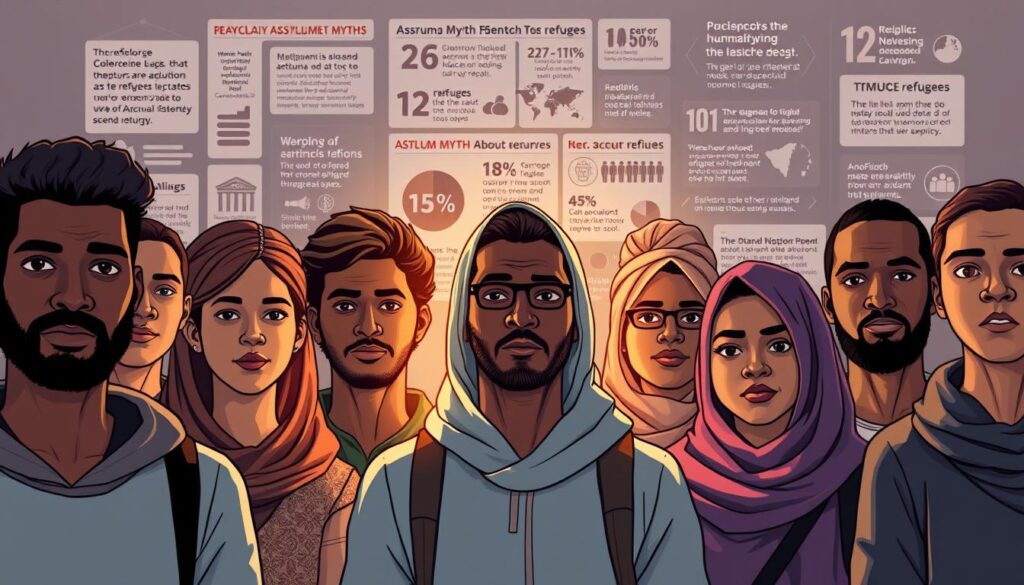Every year, thousands find safety in Canada after fleeing persecution. The country upholds its commitment under the 1951 Refugee Convention, offering protection to those in need. If you’re seeking refuge, understanding the process is crucial.
The Immigration and Refugee Board (IRB) evaluates claims fairly. You have the right to present your case and receive a decision based on Canadian law. This system ensures fairness while maintaining security.
For accurate guidance, visit the official Canada Visa Portal. It provides step-by-step details on applications and requirements. This article clarifies the journey, dispels myths, and helps you navigate the process with confidence.
Who Are Asylum Seekers in Canada?
Understanding your legal status is the first step toward securing protection in a new country. Those fleeing persecution often arrive as asylum seekers, but their status changes only after the Immigration and Refugee Board (IRB) approves their claim. Until then, they’re not officially recognized as refugees under international law.

Definition of an Asylum Seeker vs. Refugee
An asylum seeker is someone who requests safety but hasn’t yet received a decision. A refugee, however, is granted protection after proving a well-founded fear of persecution based on:
- Race or ethnicity
- Religion
- Nationality
- Membership in a particular social group
- Political opinion
The 1951 Refugee Convention defines these grounds, ensuring fairness across borders. In 2023, fewer than 1% of foreign nationals with criminal records were asylum seekers, debunking myths about security risks.
Rights Under Canadian and International Law
Your human rights are protected from the moment you arrive. Canada adheres to the non-refoulement principle, meaning you won’t be returned to danger. Key entitlements include:
“No penalties shall be imposed on refugees for illegal entry under Article 31 of the Refugee Convention.”
You also gain access to healthcare, work permits, and a fair hearing. These measures reflect the country’s commitment to dignity and justice.
Eligibility Criteria for Asylum Seekers Canada
To qualify for refuge, you must meet specific legal criteria set by authorities. The Immigration and Refugee Board (IRB) reviews each case individually, with an 80% approval rate for finalized claims. Your situation must align with international standards.

Grounds for Protection
You may qualify if facing persecution due to:
- Race, ethnicity, or nationality
- Religious or political beliefs
- Membership in a particular social group (e.g., LGBTQ+ activists)
In 2024, the IRB prioritized cases involving torture risks or state violence. Evidence like police reports or medical records strengthens claims.
Exclusions: Criminality and Security Risks
The IRB denies protection if you pose a danger to public safety. Examples include:
| Exclusion Reason | 2023 Cases |
|---|---|
| War crime involvement | 12% of rejections |
| Serious criminal record | 8% of rejections |
Even minor offenses may delay processing. Consult a lawyer if unsure about your history.
Assessing “Well-Founded Fear” of Persecution
You must prove a credible threat to your life or freedom. The IRB considers:
“Country condition reports, personal testimony, and expert opinions to evaluate risks.”
In 2023, 79% of approved applicants submitted employment records, showing community ties. Consistency in your story is critical.
How to Apply for Refugee Status in Canada
Navigating the refugee claim process in Canada requires clear steps and timely actions. The system ensures fairness while prioritizing safety. Here’s how to navigate each phase.

Step 1: Submitting Your Claim (Inland vs. Port of Entry)
You can apply asylum at a port of entry or inland. At borders, officers screen eligibility immediately. Inland applications go through Immigration, Refugees and Citizenship Canada (IRCC).
Key differences:
- Port of entry: Faster initial screening but stricter timelines.
- Inland: More time to gather evidence, but delays may occur.
Step 2: The Immigration and Refugee Board (IRB) Process
After submission, the immigration refugee board reviews your case. Expect:
- Eligibility interview within 3 weeks.
- IRB hearing within 24 months (average).
“Hearings focus on consistency and country conditions. Prepare detailed testimony.”
Step 3: After Approval or Rejection
If approved, you may apply for permanent residency via programs like the Economic Mobility Pathways Pilot. Over 3,000 healthcare workers gained PR this way during COVID.
Rejected? Options include:
- Appeal to the Refugee Appeal Division within 15 days.
- Federal Court review or humanitarian application.
For forms and updates, visit the Canada Visa Portal.
Debunking Common Myths About Asylum Seekers
Misconceptions about refugee protection often cloud public understanding. Let’s separate fact from fiction using verified data and the asylum system’s real-world impact.

Myth: “Asylum Seekers Overwhelm Canada’s System”
In 2024, claimants made up just 0.46% of the population. Compared to Türkiye (3.1 million) or Colombia (2.8 million), the world refugees hosted here are a fraction of global totals.
The IRB’s 80% approval rate shows rigorous vetting, not overload. Processing delays stem from backlog, not volume.
Myth: “Refugee Claims Are Rarely Valid”
The convention relating status sets strict criteria. In 2023, 4 out of 5 claimants proved persecution risks with evidence like:
- Medical records of torture
- Threats from authorities
“Canada’s adherence to international law ensures only credible cases succeed.”
Myth: “Asylum Seekers Don’t Contribute to Society”
Data tells a different story. By 2021, 79% of claimants were employed, generating $23 billion in annual tax revenue. Their skills fill critical gaps in healthcare and trades.
Children in the system? Just 0.5% of the under-14 demographic. These numbers reflect balance, not burden.
Conclusion
Humanitarian protection balances fairness and security in every case. The country upholds your right to safety while maintaining rigorous vetting. For 2024, prioritized resettlement includes Afghan refugee cases, reflecting global needs.
Always use the official Canada Visa Portal for updates. If your claim faces hurdles, legal aid and appeals ensure your voice is heard.
With the right tools and knowledge, you can navigate this process confidently. Trust the system—and your resilience.



